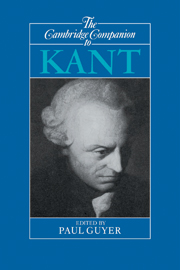Book contents
- Frontmatter
- Introduction
- 1 Kant's intellectual development
- 2 The Transcendental Aesthetic
- 3 Functions of thought and the synthesis of intuitions
- 4 The transcendental deduction of the categories
- 5 Causal laws and the foundations of natural science
- 6 Empirical, rational, and transcendental psychology
- 7 Reason and the practice of science
- 8 The critique of metaphysics
- 9 Vindicating reason
- 10 Autonomy, obligation, and virtue
- 11 Politics, freedom, and order
- 12 Taste, sublimity, and genius
- 13 Rational theology, moral faith, and religion
- 14 The first twenty years of critique
- Bibliography
- Index
13 - Rational theology, moral faith, and religion
Published online by Cambridge University Press: 28 May 2006
- Frontmatter
- Introduction
- 1 Kant's intellectual development
- 2 The Transcendental Aesthetic
- 3 Functions of thought and the synthesis of intuitions
- 4 The transcendental deduction of the categories
- 5 Causal laws and the foundations of natural science
- 6 Empirical, rational, and transcendental psychology
- 7 Reason and the practice of science
- 8 The critique of metaphysics
- 9 Vindicating reason
- 10 Autonomy, obligation, and virtue
- 11 Politics, freedom, and order
- 12 Taste, sublimity, and genius
- 13 Rational theology, moral faith, and religion
- 14 The first twenty years of critique
- Bibliography
- Index
Summary
BACKGROUND
By the middle of the seventeenth century, Lutheran theology had become an ossified and sterile orthodoxy. It was challenged by two currents of thought that were to lead to the eighteenth-century German Enlightenment. The first was Pietism, founded by Philipp Jakob Spener (1635-1705). The Pietists regarded Christian faith not as a set of doctrinal propositions but a living relationship with God. They stressed above all the felt power of God's grace to transform the believer's life through a conversion of “born again” experience. Pietism was hostile to the intellectualization of Christianity. Like Lutheran orthodoxy it exalted scriptural authority above natural reason, but for Pietism the main purpose of reading scripture was inspiration and moral edification. The experience of spiritual rebirth must transform the believer's emotions and show itself in outward conduct. Within the universities, the Pietists favored cultivation of piety and morality in life rather than theoretical inquiry. In religious controversy, they urged that the aim should be to win over the heart of one's opponent rather than to gain intellectual victory.
- Type
- Chapter
- Information
- The Cambridge Companion to Kant , pp. 394 - 416Publisher: Cambridge University PressPrint publication year: 1992
- 44
- Cited by



